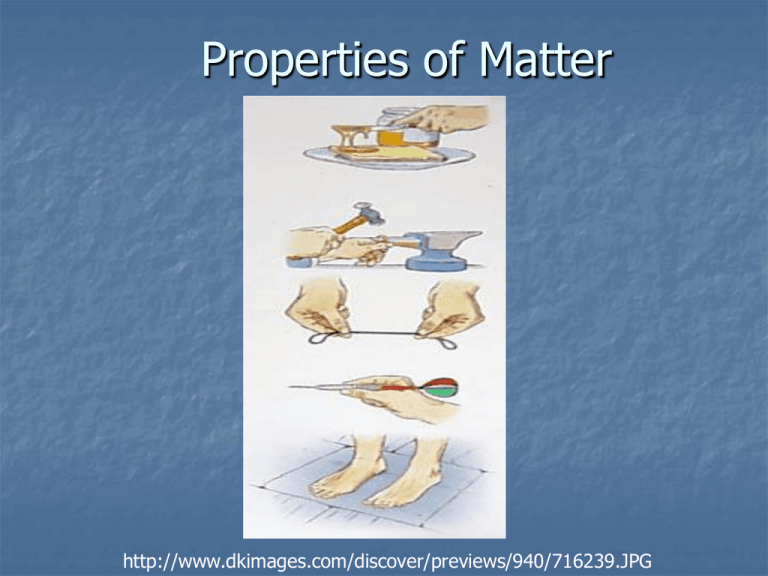Properties of Matter
advertisement

Properties of Matter http://www.dkimages.com/discover/previews/940/716239.JPG Matter has Observable Properties Physical Property: A characteristic of a substance that can be observed without changing the identity of the substance. Size Texture Color Shape Mass Volume www.dkimages.com/.../previews/968/50371334.JPG Matter has Observable Properties Physical Change: A change in any physical property of a substance, not in the substance itself. Stretching a rubber band is a physical change because the size changes however, the material that makes up the rubber band does not change www.learner.org Physical Properties DensityThe amount of matter in a given volume. D=m/v(mass/volume) Ice cubes float in water because they are less dense than liquid water www.stevespanglerscience.com/img/cache/bcb9b8... Calculating Density Density= Mass/Volume A marble has a volume of 5 cm3 and a mass of 15 g. What is the density of the marble? I: m=15 g, V= 5 cm3 F: D=M/V S:D=15g/ 5 cm3 M: D= 3 U: 3g/cm3 Physical Properties Ductility The ability to be pulled into a thin strand Wire, Paper clip, Copper wire http://us1.webpublications.com.au/static/images/articles/i1091/109181_6lo.jpg www.msm.cam.ac.uk/phase-trans/2001/adi/SGiron.jpg Physical Properties Malleability: The ability to be pressed or pounded into a thin sheet Tin foil www.questiontechnology.org/blog/offtopic/ Physical Properties Boiling Point: The temperature at which a substance changes from a liquid to a gas Water to steam www.elmhurst.edu/~chm/vchembook/163boilingpt.html Physical Properties Melting point: The temperature at which a substance changes from a solid to a liquid Ice cube melts to a puddle of water http://www.uniongas.com/images/meltingIcetechnology.jpg Physical Properties Electrical conductivity: How well a substance allows electricity to flow through it Water conducts electricity so never swim during a lightning storm genchem.chem.wisc.edu Physical Propeties Solubility: The ability to dissolve in another substance Adding sugar to coffee www.pullouttheplug.co.uk Chemical Properties of Matter Chemical Properties: Describe how substances can form new substances Chemical properties can be identified by the changes that they produce Chemical Change: The change of one substance into another substance Signs of a Chemical Change Production of an odor Eggs rotting produce a sulfur smell Lightning produces a fresh and clean smell due to its reaction with Oxygen in the atmosphere www.panelbuildersinc.net Signs of a Chemical Change Change in Temperature Exothermic Reaction: Energy is released and surrounding area of reaction increases temperature (Rusting) Endothermic Reaction: Energy is absorbed and surrounding area of reaction decreases in temperature (antacid and water) www.webergallery.com/Rusting%20Away-CT.htm www.superstock.com/stock-photos-images/1613R-7178 Signs of a Chemical Change Change in Color Fruit ripening (green tomatoes to red tomatoes) Rust www.uncp.edu/home/mcclurem/ptable/iron/fe.htm Signs of a Chemical Change Formation of Bubbles Vinegar and baking soda Antacid and water eco-centric.blogspot.com Signs of a Chemical Change Formation of a Solid or Precipitate: The shells of clams and mussels are precipitates from a chemical change of substances from the animal and sea water unsportsmanlikecomment.files.wordpress.com





